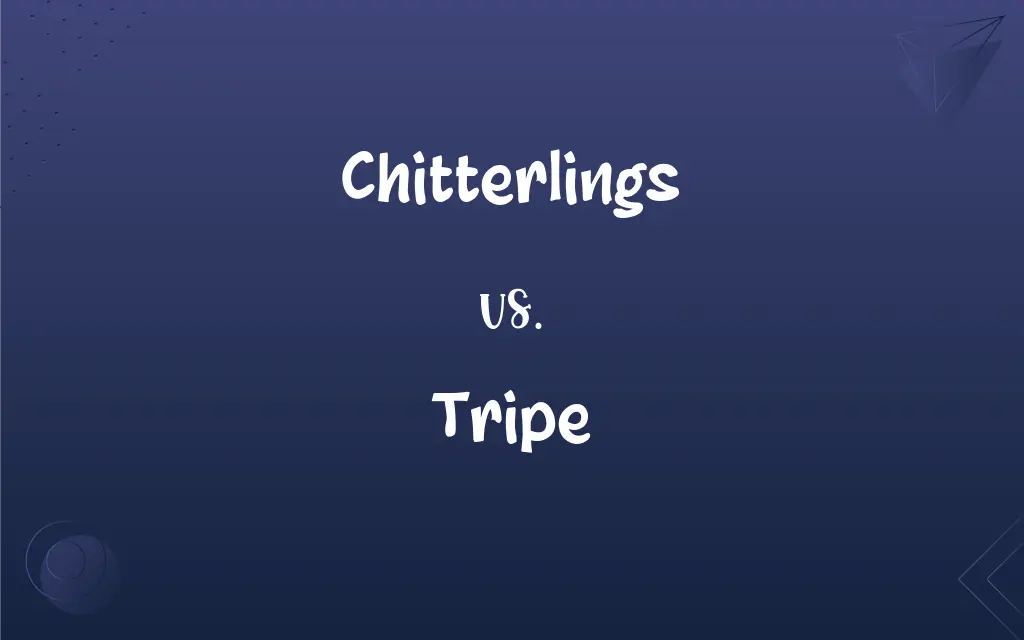Chitterlings vs. Tripe: What's the Difference?
By Aimie Carlson & Janet White || Updated on March 4, 2024
Chitterlings are the small intestines of a pig, often cleaned and cooked as food, while tripe is the stomach lining of various farm animals, used similarly in cuisine.

Key Differences
Chitterlings are a traditional Southern dish in the United States, made from the small intestines of pigs, often served boiled or fried. On the other hand, tripe comes from the stomach lining of ruminants like cows and sheep, and is popular in various global cuisines, often appearing in stews and soups.
While chitterlings are meticulously cleaned due to their origin from the digestive tract, they retain a distinctive odor that diminishes upon cooking. Tripe, meanwhile, undergoes a rigorous cleaning process to remove impurities and has a milder scent compared to chitterlings.
Chitterlings have a unique texture and flavor that is deeply rooted in African American culinary traditions, symbolizing resilience and community. Whereas tripe is celebrated for its versatility in dishes like Menudo in Mexican cuisine, and as a key ingredient in Italian and French delicacies.
The preparation of chitterlings often involves a slow-cooking method to ensure tenderness and safety, making it a labor-intensive dish. In contrast, tripe is typically pre-cooked and bleached by food processors to reduce preparation time, making it more accessible for quick dishes.
Comparison Chart
Origin
Small intestines of pigs
Stomach lining of ruminants (e.g., cows, sheep)
ADVERTISEMENT
Culinary Tradition
Southern United States, African American cuisine
Global (e.g., Mexican, Italian, French cuisines)
Odor and Cleaning
Strong odor, requires thorough cleaning
Milder odor, also needs thorough cleaning
Texture and Flavor
Unique, can be tender or chewy depending on preparation
Varied texture, generally more uniformly tender
Preparation and Cooking
Often slow-cooked for tenderness and safety
Typically pre-cooked by processors, used in various dishes
Chitterlings and Tripe Definitions
Chitterlings
Often served during special occasions, chitterlings are more than just food; they're a celebration of community and tradition.
At the community potluck, the chitterlings dish was a centerpiece, bringing everyone together in shared history and taste.
ADVERTISEMENT
Tripe
Tripe is the cleaned and cooked stomach lining from ruminants, featured in many international dishes.
In her Italian restaurant, the chef serves a delicate tripe stew, simmered with tomatoes and herbs.
Chitterlings
Chitterlings can be boiled or fried, with each method imparting a distinct texture and flavor.
After boiling the chitterlings, he crisps them up in a frying pan, adding a spicy seasoning for extra flavor.
Tripe
Its use in various global cuisines showcases tripe's adaptability, from Mexican Menudo to French Andouillette.
For his version of Menudo, he sources the finest tripe, slow-cooking it with a blend of aromatic spices.
Chitterlings
Chitterlings are the cleaned and cooked small intestines of pigs, often enjoyed in Southern cuisine.
For Thanksgiving, Grandma always prepares her special chitterlings dish, following an old family recipe.
Tripe
Beyond its taste, tripe holds cultural significance in many regions, symbolizing sustenance and innovation in cuisine.
The tripe dish at the cultural festival was not just food; it was a story of resilience and culinary creativity.
Chitterlings
They hold significant cultural value in African American communities, symbolizing history and heritage.
The annual family reunion is incomplete without the traditional chitterlings that evoke memories of our ancestors.
Tripe
Despite its simpler cleaning process compared to chitterlings, tripe also requires careful preparation to ensure quality.
The tripe must be blanched and cleaned several times before it's ready for the stew, ensuring it's free from impurities.
Chitterlings
Cleaning chitterlings is a meticulous process due to their origin in the digestive system, requiring patience and care.
Before cooking, she spends hours cleaning the chitterlings, ensuring every bit is thoroughly rinsed.
Tripe
The rubbery lining of the stomach of cattle or other ruminants, used as food.
Chitterlings
Small intestine, boiled and fried, usually of a pig. Sometimes prepared with hog maws.
Tripe
(Informal) Something of no value; rubbish.
Chitterlings
Plural of chitterling
Tripe
The lining of the large stomach of ruminating animals, when prepared for food.
Chitterlings
The smaller intestines of swine, etc., fried for food.
Tripe
The entrails; hence, humorously or in contempt, the belly.
Chitterlings
Small intestines of hogs prepared as food
Tripe
Something foolish or valueless, especially written works and popular entertainment (movies, television).
Tripe
An edible lichen, especially rock tripe.
Tripe
(pejorative) That (what has just been said) is untrue.
Tripe
The large stomach of ruminating animals, when prepared for food.
How say you to a fat tripe finely broiled ?
Tripe
The entrails; hence, humorously or in contempt, the belly; - generally used in the plural.
Tripe
Lining of the stomach of a ruminant (especially a bovine) used as food
Tripe
Nonsensical talk or writing
Tripe
Tripe can be incorporated into soups, stews, and even fried dishes, showcasing its culinary flexibility.
The crispy fried tripe appetizer, served with a spicy dipping sauce, was an unexpected hit at the food festival.
FAQs
What's the main difference between chitterlings and tripe?
The main difference lies in their origin; chitterlings come from pig intestines, while tripe is from the stomach lining of ruminants.
What is tripe?
Tripe is the cleaned and cooked stomach lining of ruminants like cows and sheep, used in various global cuisines.
How are chitterlings prepared?
Chitterlings are thoroughly cleaned, then boiled or fried, often seasoned with spices for added flavor.
What dishes use tripe?
Tripe is used in a variety of dishes, including soups like Menudo, stews, and even as a fried appetizer.
Can tripe be eaten in different cuisines?
Yes, tripe is versatile and featured in many cuisines worldwide, including Mexican, Italian, and French.
How do you clean chitterlings?
Cleaning chitterlings involves rinsing them thoroughly and removing any impurities, which can be a time-consuming process.
What are chitterlings?
Chitterlings are the cleaned and cooked small intestines of pigs, often featured in Southern and African American cuisines.
Is it safe to eat chitterlings?
Yes, when properly cleaned and cooked, chitterlings are safe to eat, though they require careful preparation to avoid contamination.
Is there a cultural significance to chitterlings?
Yes, chitterlings hold cultural significance, particularly in African American communities, symbolizing history and resilience.
Are chitterlings and tripe considered delicacies?
In some cultures, both chitterlings and tripe are considered delicacies, appreciated for their unique textures and flavors.
What does tripe taste like?
Tripe has a mild flavor, which makes it adaptable to various seasonings and cooking methods.
What are the nutritional benefits of chitterlings?
Chitterlings are high in protein but should be consumed in moderation due to their high cholesterol content.
Is tripe used in vegetarian dishes?
No, tripe is an animal product and is not suitable for vegetarian diets.
How is tripe typically cooked?
Tripe is often pre-cooked and then used in dishes like soups and stews, sometimes fried for a crispy texture.
How long do chitterlings need to be cooked?
Chitterlings should be cooked thoroughly, often for several hours, to ensure they are tender and safe to eat.
What makes tripe a popular ingredient in soups?
Tripe's mild flavor and tender texture when cooked make it a popular choice for soups, absorbing the flavors of the broth.
Can chitterlings be part of a healthy diet?
Chitterlings can be part of a diet when eaten in moderation and balanced with other nutritious foods.
Are there health benefits to eating tripe?
Tripe is a good source of protein and nutrients like selenium and vitamin B12, but like all offal, it should be eaten in moderation.
Can chitterlings be fried?
Yes, chitterlings can be fried after boiling, which adds a crispy texture and enhances their flavor.
What is the best way to store chitterlings and tripe?
Both should be stored in the refrigerator and used within a couple of days, or they can be frozen for longer storage.
About Author
Written by
Aimie CarlsonAimie Carlson, holding a master's degree in English literature, is a fervent English language enthusiast. She lends her writing talents to Difference Wiki, a prominent website that specializes in comparisons, offering readers insightful analyses that both captivate and inform.
Co-written by
Janet WhiteJanet White has been an esteemed writer and blogger for Difference Wiki. Holding a Master's degree in Science and Medical Journalism from the prestigious Boston University, she has consistently demonstrated her expertise and passion for her field. When she's not immersed in her work, Janet relishes her time exercising, delving into a good book, and cherishing moments with friends and family.































































